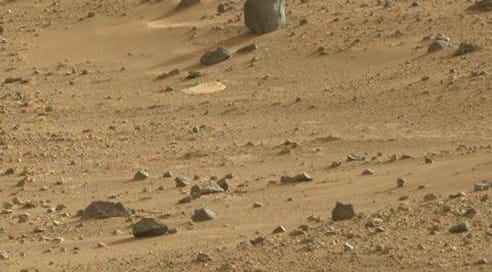Ancient Martian Drinking Vessel? Or Just a Rock?
Mars Exoarchaeology Report: #EXP001 "The Jug"

As part of my ongoing pursuit to bring credibility to the subject of Martian exoarchaeology - the hunt for alien artefacts on the surface of the Red Planet - I will today present a report of mine which takes a look at an unusual object, and decides that it’s not worth cataloguing as a potential artefact…
Here’s the initial report summary:
Details
Mars Report Ref: EXP-001
Report date: March 2021
Research Status: Closed - Explained
Description: "The Jug"
Approximate size: 15-20 cm
Mission: Curiosity Rover
Location: Gale Crater
Identified by: Javed Raza
Image date: Sol 388 Sep 2013
Image credit: NASA/JPL-Caltech/MSSS
Graphics/image editing: M. J. Craig
Image source: https://mars.nasa.gov/msl-raw-images/msss/00388/mcam/0388ML0015990240200407E01_DXXX.jpg
All raw images: Sol 388
Observations
This object stands in isolation, with nothing else unusual in the vicinity. If it were not for the apparent 'handle' appendage, it would be dismissed as just a large stone or perhaps a meteorite.
Potential as an Artificial Object
On the right-hand side, there appears to be a curved handle.
Common Explanation
A random lone rock or meteorite.
Comments: #EXP001 “The Jug”
The temptation with this object is to become totally fixated upon the handle-like shape on the right side of it, as it gives a strong visual impression of being a familiar appendage we all recognize.
As we get nearer, we think we see the right kind of shadows and fall of light to indicate a curved handle shape, and from a certain distance it is certainly persuasive. However, as we zoom in closer (Fig. 4) the detail begins to distort as the image pixels get stretched, and JPEG compression artefacts start to appear. Are our eyes being tricked? Is there really light passing through the handle opening, or is the dark line outlining the ‘handle’ which suggests a shadow, in reality just a flat mark on the rock?
Okay, let's step back from the actual object and consider the context and the question being asked here, which is:
“What is the chance that a jug or vessel, has been found somewhat intact in an open landscape in the middle of nowhere, having been exposed to at least many thousands, probably millions, of years of erosion and maybe much longer?”
Had such a thing been discovered in a somewhat sheltered area in the vicinity of a few other odd, artisan-like objects, then the possibility that it was indeed a jug or vessel of some kind, could be entertained. Out here, however, exposed to the harsh elements, and in proximity to nothing else remotely interesting, or suggestive of an ancient humanoid habitat (yes, we think ‘humanoid’, generally speaking), we must be doubtful.
Although again, to remain open-minded, had it been made at a time when Mars had plenty of oxygen, an artisan may well have used a non-corrosive metal such as bronze, which could have helped it survive to the present day, where only trace amounts of oxygen remain in the atmosphere (0.17%) to cause any damage. So it remains possible it is an artefact. That it was made with a very hard, non-corroding substance, and that on the other side of the object (if the rover had driven over to examine it… ), we might well find a second handle to confirm it.
However, my assessment leans heavily towards a natural explanation for this one, especially given the location and the existence of other similar-sized and coloured isolated rocks nearby (see Fig. 6), and that the ‘handle’ is more likely to be an optical illusion caused by the angle of viewing in the NASA image and the limitations of the JPEG file. Also, after many millions of years of erosion by wind-blown sand, we should expect, in this exposed position, that such a small metallic artefact would have been ground to dust by now. Hence, I therefore consider it much more likely that ‘The Jug’ is just a common rock or meteorite.
Yes, I'm in effect overriding what my eyes want to see, which is quite clearly a ‘handle’ attached to some kind of ‘container, jug, urn’ or something similar. You just have to see beyond what the visual picture suggests from your Earth-based experience, and remember that it is only a flat 2D image you are looking at, which has its limits in terms of what information it can give you.
It's very important I feel to remain as objective, reasonable and rational as possible while searching for alien artefacts on the Planet Mars, a subject that is regarded by most sensible folk as completely irrational anyway. Being critical and aware of your own proclivity towards interpretation, therefore, will provide you with a much better chance of finding something truly remarkable.
So, yes, I'm ruling out "The Jug" as a potential Martian artefact, because I think it falls firmly outside the mark.
Let future Martian exoarchaeologists be my judge!
© 2023 M. J. Craig









Incredible! BTW, is that the right raw source file?